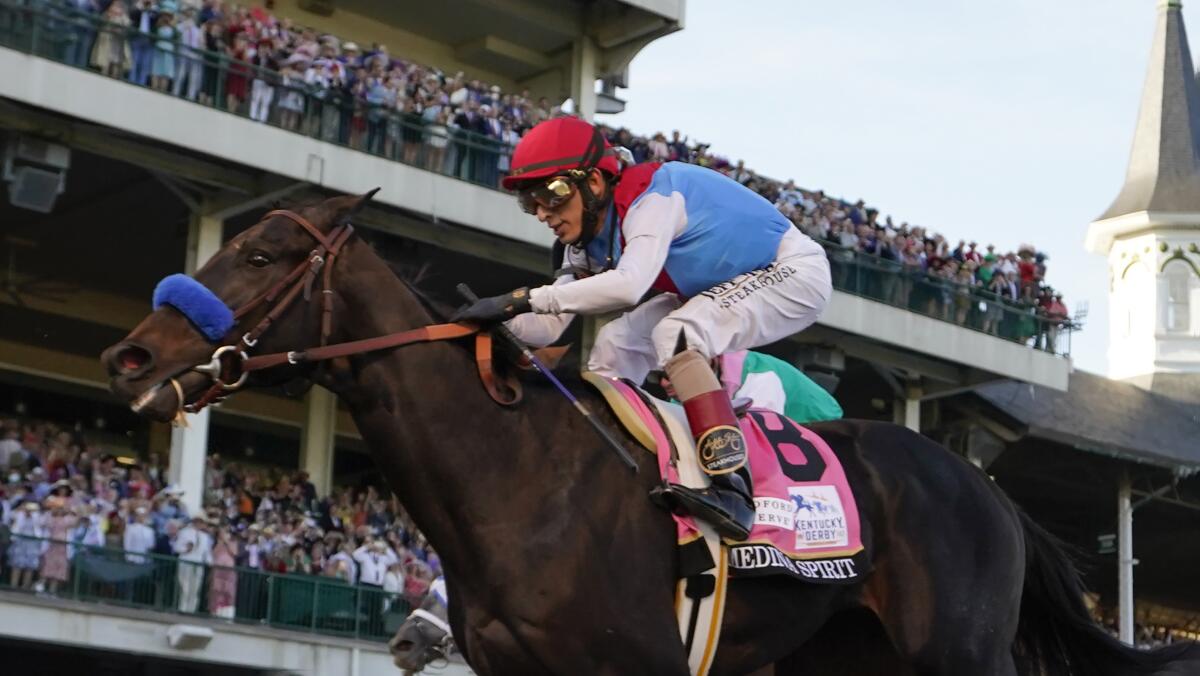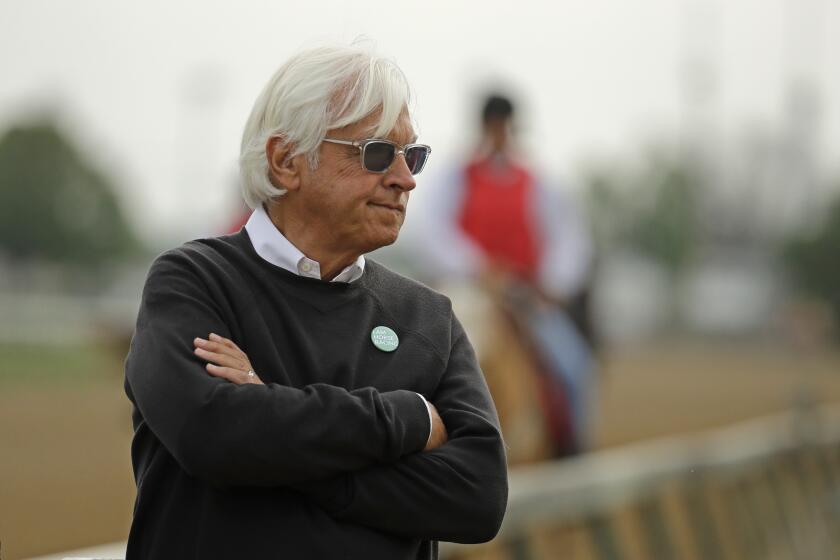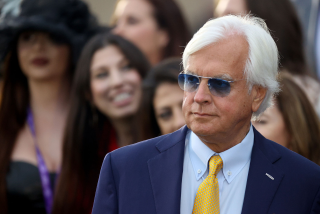Churchill Downs suspends Bob Baffert after Medina Spirit fails second drug test

- Share via
ELMONT, N.Y. — Hall of Fame trainer Bob Baffert was suspended for two years by Churchill Downs on Wednesday, the announcement coming hours after Baffert’s attorney confirmed the split sample of this year’s conditional Kentucky Derby winner, Medina Spirit, also came back with a medication positive.
Baffert has built his reputation on being able to win Triple Crown races in general and the Kentucky Derby in particular. Medina Spirit was thought to be Baffert’s seventh Derby winner and 17th Triple Crown victory.
The move by Churchill Downs no doubt will set off litigation to try to overturn the decision. If Baffert is not allowed to enter horses with the goal of winning the Kentucky Derby, the move would impact his business seriously and further harm his reputation. The ban is in effect until after the Churchill Downs 2023 Spring meeting.
Craig Robertson, who represents Baffert in matters regarding state regulatory boards, said he did not represent Baffert in the Churchill Downs matter and would have no comment.
Churchill Downs, the home to the Kentucky Derby for 147 years, seemed unwavering in its decision.
“[Churchill Downs Inc.] has consistently advocated for strict medication regulations so that we can confidently ensure that horses are fit to race and the races are conducted fairly,” said Bill Carstanjen, chief executive of CDI. “Reckless practices and substance violations that jeopardize the safety of our equine and human athletes or compromise the integrity of our sport are not acceptable and as a company we must take measures to demonstrate that they will not be tolerated.
“Mr. Baffert’s record of testing failures threatens public confidence in thoroughbred racing and the reputation of the Kentucky Derby. Given these repeated failures over the last year, including the increasingly extraordinary explanations, we firmly believe that asserting our rights to impose these measures is our duty and responsibility.”
Kentucky Derby winner Medina Spirit passed a drug test and is cleared to run at the Preakness Stakes, where trainer Bob Baffert has become the story without being present.
The actions by Churchill Downs are separate from those that might be taken by the Kentucky Horse Racing Commission, which will decide if Medina Spirit is disqualified. No hearing date has been set.
If Medina Spirit were to be disqualified for a medication violation, it would only be the second time in the history of the race. In 1968, Dancer’s Image was disqualified for having phenylbutazone, an anti-inflammatory, in his system. It took four years to settle the case after extensive litigation.
Baffert, considered the face of racing because of his success, has been dogged by medication positives the past year-and-a-half. This is his fifth violation during that time. In two of the cases, he was fined with no penalty to the horse or ownership because the positives were caused by inadvertent contamination that also affected other barns. His explanations for the positives included giving a horse medication outside the 14-day allowable window and a groom, who had taken cough medicine, urinating in a stall.
The penalties by the KHSC would be much less severe. In addition to disqualification and forfeiture of all purse money, if found guilty, Baffert could be suspended for between 10 and 30 days and fined $1,500 to $2,500. It would be Baffert’s second Class C violation in Kentucky within a year. The filly Gamine tested positive for betamethasone after running in the Kentucky Oaks in September. A suspension in Kentucky would be honored by every jurisdiction, including California.
The suspension of a trainer by a race track is not unprecedented. Two years ago, the Stronach Group — owner of Santa Anita, Golden Gate and other tracks — suspended Jerry Hollendorfer for what they believed to be excessive fatalities of his horses. Hollendorfer filed suit and received a temporary restraining order that allowed him to run at Del Mar. He also filed suit to be able to run in Los Angeles and Alameda Counties but was denied. The case against TSG is awaiting trial.
A message left for Josh Rubinstein, chief operating officer at Del Mar, to see if Del Mar planned any action against Baffert during its upcoming summer meeting was not immediately returned.
Santa Anita, which only has three weeks of racing left in its meeting, issued a statement saying: “[The KHRC] has not released all of the information nor has it offered a ruling on this matter. We will continue to await action by the KHRC and will make a decision once their regulatory process is complete.”
Robertson confirmed this morning that “the Medina Spirit split sample confirmed the finding of betamethasone at 25 picograms.” The original sample found 21 picograms in the horse’s system. A picogram is a trillionth of a gram. There is no allowable limit for the medication on race day in Kentucky. The split sample testing was done by the Maddy Lab at UC Davis.
Betamethasone is corticosteroid that primarily is used as an anti-inflammatory on both people and animals. It is not considered a performance enhancer and its use is legal but needs to be out of the horse’s system by race day. The typical withdrawal window is 14 days or less.
The reason regulators don’t want horses on the medication when they race is so veterinarians can feel for heat on the animals’ limbs in pre-race examinations, according to Dr. Mary Scollay, executive director and chief operating officer at the RMTC.
Bob Baffert was suspended Monday from entering horses at New York racetracks, pending an investigation into the failed drug test of Kentucky Derby winner Medina Spirit.
“You don’t want to increase the chance of injury by not being able to detect a problem,” Scollay told The Times last month. “It helps the trainer, groom, everyone who comes in contact with the horse. You don’t want medication to fool them into poor decision-making.”
The KHRC has yet to confirm the positive. It was made public by Baffert about a week after the Kentucky Derby. At first, he said he had no idea how the drug got in the horse’s system. He went on various media outlets defending his horse and proclaiming innocence. In one interview with Fox, he blamed “cancel culture.”
However, two days later he said they had found the source of the drug and it was an ointment that was being used to treat a skin rash on the right-hind quarter of Medina Spirit. The treatment started shortly after the Santa Anita Derby and continued until the day before the Kentucky Derby. Betamethasone is usually administered to horses by injection but also comes as a topical.
The New York Racing Assn., which conducts the Belmont Stakes on Saturday — the third leg of the Triple Crown — has a temporary ban on Baffert.
More to Read
Go beyond the scoreboard
Get the latest on L.A.'s teams in the daily Sports Report newsletter.
You may occasionally receive promotional content from the Los Angeles Times.













